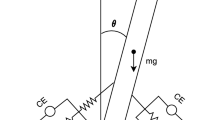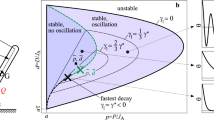Abstract
Control of bipedal standing is typically analyzed in the context of a single-segment inverted pendulum model. The stiffness K SE of the series elastic element that transmits the force generated by the contractile elements of the ankle plantarflexors to the skeletal system has been reported to be smaller in magnitude than the destabilizing gravitational stiffness K g . In this study, we assess, in case K SE + K g < 0, if bipedal standing can be locally stable under direct feedback of contractile element length, contractile element velocity (both sensed by muscle spindles) and muscle force (sensed by Golgi tendon organs) to alpha-motoneuron activity. A theoretical analysis reveals that even though positive feedback of force may increase the stiffness of the muscle–tendon complex to values well over the destabilizing gravitational stiffness, dynamic instability makes it impossible to obtain locally stable standing under the conditions assumed.
Similar content being viewed by others

References
Alexander RMcN, Bennett-Clark HC (1977) Storage of elastic strain energy in muscle and other tissues. Nature 265: 114–117
Anderson JH (1974) Dynamic characteristics of Golgi tendon organs. Brain Res 67: 531–537
Bahler AS (1967) Series elastic component of mammalian skeletal muscle. Am J Physiol 213: 1560–1564
Barin K (1989) Evaluation of a generalized model of human postural dynamics and control in the sagittal plane. Biol Cybern 61: 37–50
Bernstein N (1967) Coordination and regulation of movements. Pergamon Press, New York
Bobbert MF, Huijing PA, van Ingen Schenau GJ (1986) An estimation of power output and work done by the human triceps surae muscle–tendon complex in jumping. J Biomech 19: 899–906
Cordo PJ, Flores-Vieira C, Verschueren SM, Inglis JT, Gurfinkel V (2002) Position sensitivity of human muscle spindles: single afferent and population representations. J Neurophysiol 87: 1186–1195
Crago PE, Hauk J, Rymer WZ (1982) Sampling of total muscle force by tendon organs. J Neurophysiol 47: 1069–1083
Diener HC, Dichgans J, Guschlbauer B, Mau H (1984) The significance of proprioception on postural stabilization as assessed by ischemia. Brain Res 296: 103–109
Diener HC, Horak FB, Nashner LM (1988) Influence of stimulus parameters on human postural responses. J Neurophysiol 59: 1888–1905
Dietz V, Gollhofer A, Kleiber M, Trippel M (1992) Dependency on load receptors, regulation of bipedal stance. Exp Brain Res 89: 229–231
Edwards WT (2007) Effect of joint stiffness on standing stability. Gait Posture 25: 432–439
Fitzpatrick RC, Burke D, Gandevia SC (1996) Loop gain of reflexes controlling human standing measured with the use of postural and vestibular disturbances. J Neurophysiol 76: 3994–4008
Fitzpatrick RC, Taylor JL, McCloskey DI (1992) Ankle stiffness of standing humans in response to imperceptible perturbation: reflex and task-dependent components. J Physiol 454: 533–547
Gatev P, Thomas S, Kepple T, Hallett T (1999) Feedforward ankle strategy of balanace during quiet stance in adults. J Physiol 514: 915–928
Gurfinkel VS, Osevets SM (1972) Dynamics of the equilibrium of the vertical posture in man. Biophysics 17: 496–506
Haftel VK, Bichler EK, Nichols TR, Pinter MJ, Cope TC (2004) Movement reduces the dynamic response of muscle spindle afferents and motoneuron synaptic potentials in rat. J Neurophysiol 91: 2164–2171
Hof AL (1998) In vivo measurement of the series elasticity release curve of human tricpes surae muscle. J Biomech 31: 793–800
Hogan N, Bizzi E, Mussa-Ivaldi FA, Flash T (1987) Controlling multijoint motor behavior. Exerc Sports Sci Rev 15: 153–190
Horak FB, Macpherson JM (1996) Postural orientation and equilibrium. In: Rowell LB, Shepherd JT(eds) Handbook of physiology. Exercise regulation and integration of multiple systems. Oxford, New York, pp 255–292
Houk JC, Henneman E (1967) Responses of Golgi Tendon organs to active contractions of the soleus muscle of the cat. J Neurophysiol 30: 466–481
Hsu WL, Scholz JP, Schoner G, Jeka JJ, Kiemel T (2007) Control and estimation of posture during quiet stance depends on multijoint coordination. J Neurophysiol 97: 3024–3035
Hurwitz A (1895) Über die Bedingungen, unter welchen eine Gleichung nur Wurzeln mit negativen reellen Teilen besitzt. Math Ann 46: 273–284
Jankowska E (1992) Interneuronal relay in spinal pathways from proprioceptors. Progr Neurobiol 38: 335–378
Joseph J, Nightingale A (1952) Electromyography of muscle sof posture: leg muscles in males. J Physiol 117: 484–491
van der Kooij H, Jacobs R, Koopman B, Grootenboer H (1999) A multisensory integration model of human stance control. Biol Cybern 80: 299–308
Kuo A (1995) An optimal control model for analyzing human postural balance. IEEE Trans Biomed Eng 42: 87–101
Lockhart DB, Ting LH (2007) Optimal sensorimotor transformations for balance. Nat Neurosci 10: 1329–1336
Loram ID, Lakie M (2002a) Direct measurement of human ankle stiffness during quiet standing: the intrinsic mechanical stiffness in insufficient for stability. J Physiol 545: 1041–1053
Loram ID, Lakie M (2002b) Human balancing of an inverted pendulum: position control by small, ballistic-like, throw and catch movements. J Physiol 540: 1111–1124
Loram ID, Maganaris CN, Lakie M (2005a) Active, non-spring-like muscle movements in human postural sway: how might paradoxical changes in muscle length be produced?. J Physiol 564: 281– 293
Loram ID, Maganaris CN, Lakie M (2005b) Human postural sway results from frequent, ballistic bias impulses by soleus and gastrocnemius. J Physiol 564: 295–311
Loram ID, Maganaris CN, Lakie M (2007) The passive, human calf muscle in relation to standing: the short range stiffness lies in the contractile component. J Physiol 584: 677–692
Mauritz KH, Dietz V (1980) Characteristics of postural instability induced by ischaemic blocking of leg afferents. Exp Brain Res 38: 117–119
Morasso PG, Sanguineti V (2001) Ankle muscle stiffness alone cannot stabilize balance during quiet standing. J Neurophysiol 88: 2157–2162
Nashner LM (1976) Adapting reflexes controlling the human posture. Exp Brain Res 26: 59–72
Nichols TR, Houk JC (1973) Reflex compensation for variations in the mechanical properties of a muscle. Science 181: 182–184
Nichols TR (1989) The organization of heterogenic reflexes among muscles crossing the ankle joint in the decerebrate cat. J Physiol 410: 463–477
Peterka RJ (2002) Sensorimotor integration in hman postural control. J Neurophysiol 88: 1097–1118
Pinter IJ, van Swighem R, van Soest AJ, Rozendaal LA (2006) Postural sway cannot be described using a one-segment inverted pendulum model. Gait Posture 24: S98–S99
Pratt CA (1995) Evidence of positive force feedback among hindlimb extensors in the intact standing cat. J Neurophysiol 73: 2578–2583
Prilutsky BI, Herzog W, Leonard TR, Allinger TL (1996) Role of the muscle belly and tendon of soleus, gastrocnemius and plantaris in mechanical energy absorption and generation during cat locomotion. J Biomech 29: 417–434
Prochazka A, Gillard D, Bennett DJ (1997) Implications of positive feedback control of movement. J Neurophysiol 77: 3237–3251
Prochazka A, Gillard D, Bennett DJ (1997) Positive force feedback control of muscles. J Neurophysiol 77: 3226–3236
Proske U, Morgan DL (1987) Tendon stiffness: methods of measurement and significance for the control of movement. A review. J Biomech 20: 75–82
Rack PMH (1981) Limitations of somatosensory feedback in control of posture and movement. In: Handbook of Physiology. The Nervous System. Motor Control. American Physiological Society, Bethesda, pp 229–256
Routh EJ (1877) A treatise on the stability of a given state of motion. Macmillan, London
Rozendaal LA, van Soest AJ (2005) Joint stiffness requirements in a multi-segment stance model. In: Proceedings of XXst ISB Conference, Cleveland
Rozendaal LA, van Soest AJ (2007) Multi-segment stance can be stable with zero local ankle stiffness. In: Proceedings of XXIst ISB Conference, Taipei
van Soest AJ, Bobbert MF (1993) The contribution of muscle properties in the control of explosive movements. Biol Cybern 69: 195–204
van Soest AJ, Haenen WP, Rozendaal LA (2003) Stability of bipedal stance: the contribution of cocontraction and spindle feedback. Biol Cybern 88: 293–301
Verdaasdonk BW, Koopman HFJM, van Gils SA, van der Helm FCT (2004) Bifurcation and stability analysis in musculoskeletal systems: a study in human stance. Biol Cybern 91: 48–62
Winter DA, Patla AE, Prince F, Ishac M, Gielo-Perczak K (1998) Stiffness control of balance in quiet standing. J Neurophysiol 80: 1211–1221
Winter DA, Patla AE, Rietdyk S, Ishac MG (2001) Ankle muscle stiffness in the control of balance during quiet standing. J Neurophysiol 85: 2630–2633
Zajac FE (1989) Muscle and tendon: properties, models, scaling, and application to biomechanics and motor control. In: Bourne JR(eds) Crit Rev Biomed Eng 17. CRC Press, Boca Raton, pp 359–411
de Zee M, Voigt M (2001) Moment dependency of the series elastic stiffness in the human plantar flexors measured in vivo. J Biomech 34: 1399–1406
Author information
Authors and Affiliations
Corresponding author
Rights and permissions
About this article
Cite this article
van Soest, A.J.“., Rozendaal, L.A. The inverted pendulum model of bipedal standing cannot be stabilized through direct feedback of force and contractile element length and velocity at realistic series elastic element stiffness. Biol Cybern 99, 29–41 (2008). https://doi.org/10.1007/s00422-008-0240-2
Received:
Accepted:
Published:
Issue Date:
DOI: https://doi.org/10.1007/s00422-008-0240-2



